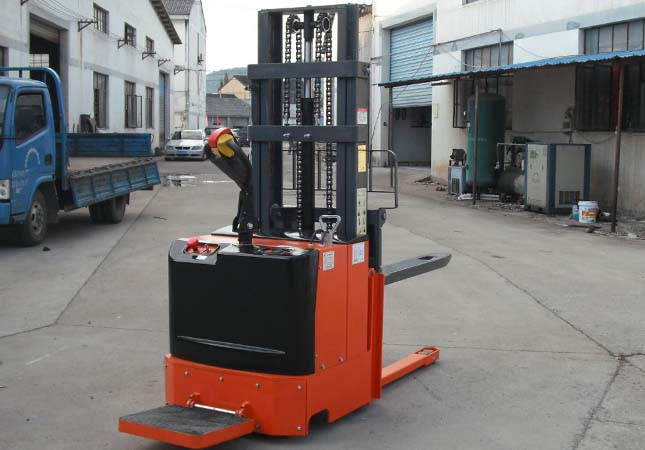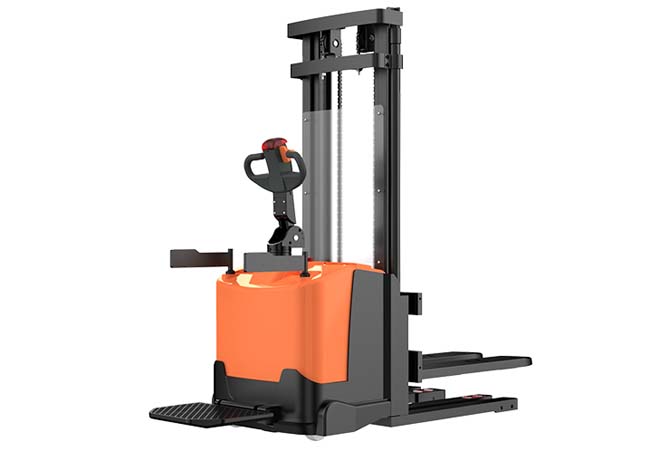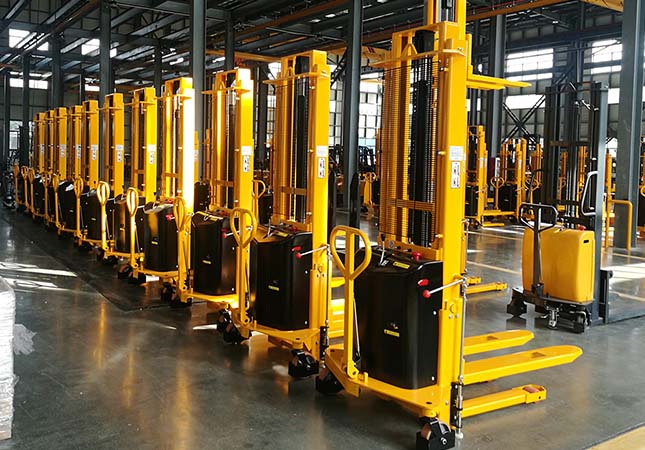The electric hydraulic stacker, also known as an electric stacker or electric stacking machine, is an apparatus that utilizes an electric hydraulic device to elevate heavy loads. This type of equipment is commonly used in various circulation links of warehouses, workshops, loading and unloading, and other items in factories. It plays a pivotal role alongside forklifts in modern warehousing logistics.

Difference Between Semi-Electric Stacker and Fully Electric Stacker
The electric pallet truck can be divided into two types: fully electric pallet truck and semi-electric pallet truck. The fully electric pallet truck, as the name suggests, utilizes electric power to drive both the lifting mechanism and the driving mechanism, and is commonly referred to as a fully electric or fully automated pallet truck. The driving mechanism is powered by a battery-driven motor that drives the wheels to achieve movement and positioning. The lifting mechanism utilizes an electric motor to drive the hydraulic station, which in turn pushes the hydraulic cylinder to achieve the lifting action. Simply put, both the lifting and movement are achieved through electric power.
The semi-electric pallet truck performs similar functions to the fully electric pallet truck but lacks a driving mechanism. It has only a few basic load-bearing and directional wheels, and therefore requires manual pushing for movement. The lifting function is achieved through an electric motor that drives the hydraulic station to push the hydraulic cylinder for lifting the goods. Therefore, compared to the semi-electric pallet truck, the fully electric pallet truck is much more efficient and labor-saving in terms of usage. The difference in their design also determines the difference in their usage range.
The main function of the semi-electric stacker is to lift and lower goods, and it is mainly used for operations that require small-range movement, such as loading and unloading, warehouse stacking, and high-altitude picking. In contrast, the main function of the fully electric stacker is to lift and transport goods, mainly used for picking goods from warehouses, stacking goods on shelves, and transporting items. The fully automatic stacker can largely replace electric forklifts and manual handling operations.
Here is a comparison of the main advantages and disadvantages between the 2 types of stackers:
|
|
Semi-Electric Stacker
|
Fully Electric Stacker
|
|
Advantages |
Simple operation, low cost, wide range of practical applications, easy maintenance, and low requirements for aisle width.
|
Easy operation, powerful functions, safe to use, higher and heavier lifting capacity, durable battery life, noiseless, low maintenance, can replace manual handling operations to a certain extent, more cost-effective than forklifts, can lift up to 2 tons, and can lift to heights of over 6 meters.
|
|
Disadvantages |
High physical effort required for movement, lower safety factor, short battery life, not suitable for carrying loads over 1.2 tons, significant changes in load capacity with the height of the lift, and most semi-electric stackers cannot carry the rated weight at their highest lift. |
Much more expensive than semi-electric stackers, requires wider aisle width, difficult to turn in narrow spaces, heavy weight, and need to consider the load-bearing capacity of the floor in multi-story buildings or other areas.
|
Common faults of Semi-Electric Stacker
The fork of the semi-electric stacker can be fixed or movable with a pallet. The thickness of the movable fork is default at 70mm and can be customized to a smaller or larger thickness as per special requirements. The root of the movable fork is connected to the stacker through a shim, and the height of the shim can be adjusted by screws to achieve the purpose of adjusting the height of the fork's front end.
Oil leakage in the semi-electric stacker is mostly caused by loose connections between oil pipes, oil cylinders, or pump stations. The leakage can be fixed by tightening the nuts at the connection with a wrench, but be careful not to overtighten and cause thread slippage. If the leakage persists even after tightening the nuts, the nuts need to be removed, and the gasket or explosion-proof valve replaced with the correct type or a new one before retightening. This type of fault can generally be resolved. When removing the nuts, the forks must be lowered to the lowest position to ensure that the hydraulic oil in the oil circuit returns to the pump station's oil cylinder to avoid excessive leakage.
The left and right balance wheels of the semi-electric stacker may become unlevel due to the stacker deviating from the center of gravity during daily loading, causing excessive pressure on one side. In this case, the rear cover can be opened, and the screws on the left and right balance wheels can be loosened to add shims to the lower balance wheel shaft or reduce shims on the higher balance wheel to achieve left and right balance.
The electrical part of the semi-electric stacker rarely has faults, but proper maintenance and usage are necessary. For example, the stacker should not be used under voltage, and it should not be used while charging. If not used for a period, the stacker must be regularly charged to maintain sufficient battery energy and avoid rain. If the power supply in the usage environment is unstable, it is best to add a voltage stabilizer facility. Overloading should be avoided.
SUNTECH Electric Stacker
SUNTECH Electric Stackers are all designed to be efficient, durable, and versatile, which meet diverse demands of busy warehouses, manufacturing facilities, and distribution centers, where moving goods quickly and safely is critical.
ST-MBT-10 Electric Stacker is a versatile solution for a variety of applications, offering convenient and easy operation. Ideal for use in shops, factories, and small stores, this fully powered stacker delivers exceptional performance while taking up minimal space. In addition to its standard specifications, the stacker can be tailored to meet specific requirements for loading devices, carrying capacity, lifting height, and more.

Some of the standout features of this electric stacker include its double lift cylinder design, which ensures accurate and smooth lifting, and its unique wide-view mast design, which greatly enhances operator visibility. Furthermore, the inclusion of an explosion-proof valve at the bottom of the cylinder means that the mast will not rapidly decline in the event of a burst pipe, providing additional safety and peace of mind.

As a leading textile machinery manufacturer, SUNTECH Textile Machinery born to innovation and never stops in the research of the automation&intelligence manufacturing of textile machines,material handling equipment,and the textile beam storage system. With a 50-year history of involvement in intelligent machinery, SUNTECH Textile Machinery has been at the forefront of this development,and designed and produced state-of-the-art hygiene and health equipment, including spunbond non-woven fabric machines, meltblown non-woven fabric machines, meltblown machines, and hydroentangling non-woven fabric machines, as well as top-quality textile machinery, such as beam storage systems, electric warp beam lift trolley, fabric inspection machines, packaging machines, and rapier looms. Til today, we obtained over 5,000 customers and 17,000 successful customer cases globally, SUNTECH Textile Machinery has become a reliable provider of professional intelligent equipment to various international textile enterprises, making significant contributions to the global textile industry!




